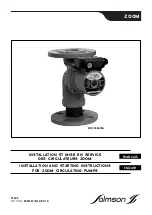
iSMA-B-MINI/MIX Modbus User Manual
www.ismacontrolli.com
DMP262en | 1st Issue rev. 8 | 05/2022
page 49 of 107
Value
OPERATION MODE Register
5
Time Relay NO [s]
6
Time Relay NC [s]
7
Input Forwarding
8
Heating (4U4O-H and 4U4O-H-IP only)
9
Cooling (4U4O-H and 4U4O-H-IP only)
Table 35. Special application modes
The operating mode can be changed by writing the right value in the Operation Mode
register.
Special modes are initialized after 3 seconds from the power-up or restart of the module
(the time value needed to stabilize the operation of the analog transmitter).
With each change of the input mode, the assigned output is set to default state and the
timer used in time-based modes is reset. If the recently selected operating mode is
running, the output is controlled according to the new mode activated.
Ordinary IO
In this mode, the module operates as a standard IO; the inputs and the outputs are in no
relation with each other.
Monostable Relay
In this mode, both the rising and the falling edge of the digital input change the output
state. The action of a monostable relay can be executed remotely by changing the state of
bit from false to true in the COMMAND register (40020). Outputs can by also overwritten
with the DIGITAL OUTPUT register (40018), which allows remote control from BMS.
Bistable Relay
In this mode, only the rising edge of the digital input changes the output state. The action
of a bistable relay can be executed remotely by changing the state of bit from false to
true in the COMMAND register (40020). Outputs can be also overwritten by the DIGITAL
OUTPUT register (40018 ), which allows remote control from BMS.
Time Relay NO [ms]
In this mode, if the output value is false, the rising edge of the digital input sets the output
to a true value. Every falling edge of the digital input starts the counter from the
beginning so that the output stays in a true value for the time defined in the TIME VALUE
register (expressed in milliseconds), counting from the last falling edge of the digital input.
The action of the time relay can be executed remotely by changing the state from false to
true in the relevant COMMAND register (40020). The outputs can be also overwritten with
the register of the DIGITAL OUTPUT module (40018), which allows for remote control
from BMS.















































